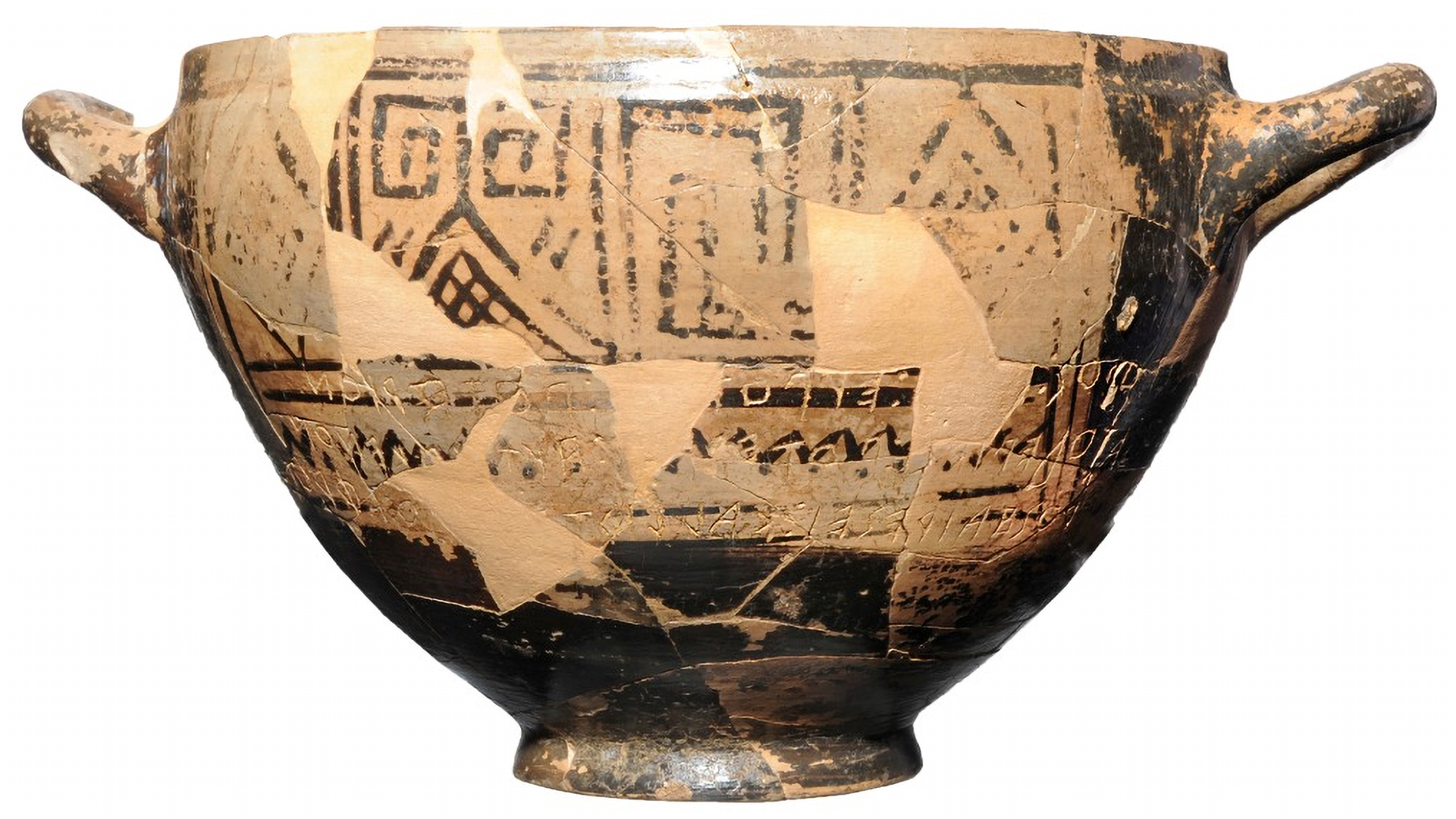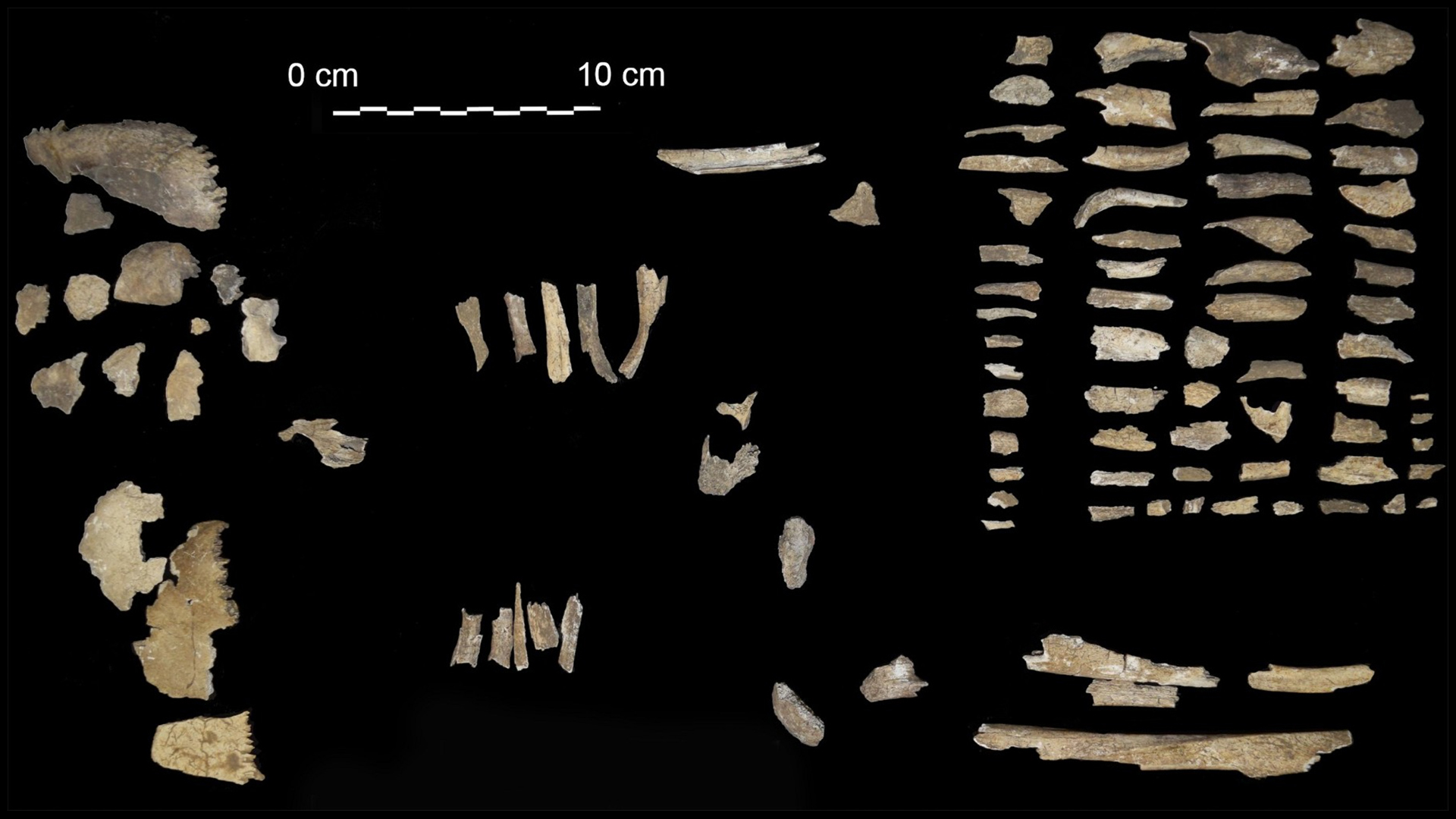Burial that included a racy love goddess inscription held multiple people
The burned bone fragments belonged to at least three adults.

An ancient Greek cremation burial dating to nearly 3,000 years ago was more crowded than expected, scientists recently discovered. The tomb was thought to hold a single occupant — a child — but new analysis of the tomb’s bones revealed that it instead held the remains of at least three adults.
This could help to explain a longstanding mystery: the presence in the tomb of a cup with a racy inscription that seemed out of place in a child's grave.
The clay vessel, known as Nestor's Cup, bears a three-line boast ending with a promise that whoever drank from the cup would be smitten with desire for Aphrodite, goddess of beauty and love. Experts have long puzzled over why such a message would be preserved in the burial of a child, and the recent findings may help to explain it, scientists reported in a new study.
Related: 25 grisly archaeological discoveries
"We can say that we re-opened a cold case," lead study author Melania Gigante, a postdoctoral researcher in the Department of Cultural Heritage at the University of Padua in Italy, told Live Science in an email.
The burial is part of an ancient site called Pithekoussai, an ancient Greek city and necropolis on the island of Ischia in Italy. It dates to the eighth century B.C., and archaeologists excavated approximately 1,300 tombs there between 1952 and 1982. One of the tombs, identified as "Cremation 168," is more widely known as the "Tomb of Nestor's Cup" after an inscribed vessel for drinking wine, known as a kotyle, that was discovered there. The cup bears one of the oldest surviving examples of Greek writing, the study authors reported Oct. 6 in the journal PLOS One.
In the epic Greek poem "The Iliad," Homer described a beautiful golden cup that only its owner, the hero Nestor, could lift. According to legends of the time, adventurers would drink a fortifying beverage from its depths. By comparison, the clay vessel found in Tomb 168 is a simple cup. But its inscription claims otherwise in a nod to Nestor's mythical goblet, according to the Joukowsky Institute for Archaeology and the Ancient World at Brown University in Providence, Rhode Island.
Sign up for the Live Science daily newsletter now
Get the world’s most fascinating discoveries delivered straight to your inbox.
Three lines of text in the Greek alphabet are written on the clay cup in hexameter (a line of verse with six accents), thought to be an allusion to Homer's poetry. The text reads: "I am Nestor's cup, good to drink from. Whoever drinks this cup empty, straightaway Desire for beautiful-crowned Aphrodite will seize him," according to the institute.

The burial held 195 bone fragments, and the researchers used microscopy to examine details in the surfaces and internal tissues, with some conclusive results on 175 fragments. To their surprise, they found that only 130 of the bones were human; 45 bone fragments came from animals. Some of those bones likely belonged to sheep, and other bones may have belonged to dogs and birds, but the pieces were so broken that the scientists were unable to identify most of the fragments with certainty, according to the study.
When the scientists looked at the human bones — mostly bits of large bones from the arms and legs — they examined formations that emerge as bone tissue renews itself over time. By comparing the density of these formations across specimens, they saw that the fragments belonged to three individuals. The bones also indicated that the people were adults that were no longer growing; while it wasn't possible to determine how old they were or if they were related, the findings ruled out the possibility that the tomb held a child, the researchers wrote.
"Unfortunately, given the high fragmentation of the samples and the fire action, we are unable to say more," Gigante said.
Human and animal remains showed similar burn patterns, hinting that they were burned together or using the same methods, and the animals in the grave may represent food offerings for the dead "or companions in the journey to the afterlife," according to the study.
"I am not surprised to have received yet another confirmation of how much there is still to be discovered about Pithekoussai," Gigante said. "This study is only the first step towards a more complete interpretation not only of the Tomb of Nestor's Cup, but also of the customs and funerary uses at the dawn of Magna Graecia [Greater Greece]," she said.
Originally published on Live Science.

Mindy Weisberger is an editor at Scholastic and a former Live Science channel editor and senior writer. She has reported on general science, covering climate change, paleontology, biology and space. Mindy studied film at Columbia University; prior to Live Science she produced, wrote and directed media for the American Museum of Natural History in New York City. Her videos about dinosaurs, astrophysics, biodiversity and evolution appear in museums and science centers worldwide, earning awards such as the CINE Golden Eagle and the Communicator Award of Excellence. Her writing has also appeared in Scientific American, The Washington Post and How It Works Magazine. Her book "Rise of the Zombie Bugs: The Surprising Science of Parasitic Mind Control" will be published in spring 2025 by Johns Hopkins University Press.









